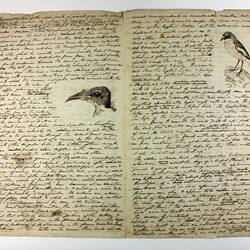Summary
Alternative Name(s): Radial Quinary System Diagram, Avian System, Taxonomic Diagram
Single page chart or diagram providing a taxonomy of birds, based on the quinary system. Believed to have been drawn by ornithologist John Cotton in Victoria some time between 1843 and 1849. It includes bird orders - divided into Raptores, Sagittores, Natatores, Grallatores, Rasores and Insessores - and tribes (as they were known in the quinary system). The back of the diagram has a series of doodles, including scribbles, letters, an eye, a stick figure of a man chasing a dog (?) near a tree, and a female figure lying on a canopied bed.
The taxonomy is part of an archive of writings by and about ornithologist John Cotton. The archive includes his diary, manuscripts and sketches, as well as transcriptions and later research notes. John Cotton's writings are likely to have come to Museum Victoria in the early 1970s during research by Allan McEvey, then Curator of Birds at Museum Victoria.
Physical Description
Single sheet of paper with circular diagram on front inscribed with scientific names for birds. Random doodles on reverse. The outer ring lists bird orders: Raptores, Sagittores, Natatores, Grallatores, Rasores and Insessores. Within this ring each order is divided into wedges containing 'tribe' names (to use the quinary classification system terminology). At the centre is a triangle labelled 'AVES', divided into red, yellow and blue - respectively identified as aerial, terrestrial and aquatorial. Many words within the diagram are crossed out, suggesting this is a working diagram.
Significance
At the time John Cotton drew this taxonomy, a tax anomic order for birds was not widely agreed by the scientific community. James Rennie had just published his Natural History of Birds: Their Architecture, Habits, and Faculties (1839), articulating the quinary system of classification for birds that was popular in England; and George Robert Gray, Assistant-Keeper of Birds at the British Museum, was working on his Genera of Birds (1844-49), based on the Cuvierian classification with its rostral system, used in France from around 1800. Charles Darwin had laid the groundwork for a taxonomy based on descent in 1859; and in 1867 Thomas Huxley constructed his celebrated ' Classification of Birds', based on Darwinian principles.
Cotton himself used the quinary system of classification. The modifications made to his diagram are a significant record of his attempt to work through the taxonomy and contribute to taxonomic thinking.
More Information
-
Collecting Areas
Migration & Cultural Diversity, Home & Community, Science & Measurement
-
Acquisition Information
Transfer from Museum Victoria Archives, Feb 2012
-
Author
-
Date Used
Melbourne, Victoria, Australia, 1970-1990
Approximate dates of research notes -
Inscriptions
Extensive. At centre: 'AVES'. Museum number at top right, in ink: 'N.M.V./0 1/5
-
Classification
-
Category
-
Discipline
-
Type of item
-
Overall Dimensions
173 mm (Width), 207 mm (Height)
-
Maximum dimensions
206 mm (Length), 700 mm (Width)
Measurement From Conservation.
-
References
The History of the Collections Contained in the Natural History Departments of the British Museum, vol.II, 1906, p.82 onwards (particularly noting the work of the Keeper and Assistant Keepers of Birds, brothers J.E. and G.R. Gray.
-
Keywords



